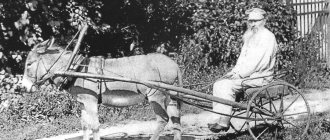Essay: Features of A.A Fet’s lyrics (briefly)
Afanasy Afanasyevich Fet is a famous poet who made a great contribution to the development of Russian literature. In his poems, the poet depicted the world around him with subtle strokes, endowing nature with human traits. Let's take a closer look at what are the features of the lyrics in Fet's poetry.
One of the main features of Fet’s work is the fundamental position of “pure art” that he adhered to. Only beauty, love, creation, and creativity became the themes of his works. He did not touch upon any social or political aspects of existence. Opening Fet's collection, the reader is immersed in the world of the amazing and beautiful, forgets about his problems, completely immersing himself in art. Absolutely all of Fet’s works are filled with strong feelings. After all, Fet didn’t just write poetry, he admired the surrounding beauty, love, and nature. This is the main features of the poet’s lyrics.
Passing Fet's poems through the soul, the reader sees a palette of emotions and moods that evoke the brightest and most pleasant feelings. In Fet's poetry one can only find a delightful description of nature, conveying in detail the state of the inner world of the lyrical hero. The great skill of the Russian poet is very subtly and gracefully intertwined with the beauty of the Russian landscape. At the center of Afanasy Fet’s work are landscape and love lyrics. Only in his later poems did the poet touch upon philosophical themes.
Fet's love lyrics live on to this day: we often hear his poems in the form of romances. Almost all of them are imbued with sadness. It is no secret that the poet’s beloved passed away early. The poet expressed all his feelings for his beloved in poems, which he dedicated to her until the end of his life. The peculiarity of Fet's love lyrics is that his poems lack dramatic and tragic notes. Fet's lyrics are filled with smoothness and musicality. It is impossible to find motives of jealousy, longing and passion in it. The author glorifies this wonderful feeling, describing only its positive aspects.
“At dawn, don’t wake her, At dawn she sleeps so sweetly; Morning breathes on her chest, shines brightly on her cheeks.”
Fet's love lyrics consist of poems about sublime and ideal love. Mostly they were written by the poet in old age.
“What happiness: it’s night and we’re alone! The river is like a mirror and all sparkles with stars; And there... throw your head back and look: what depth and purity is above us!
In addition, abstract images predominate in Fet’s work: we hardly see a description of the beloved, we do not know the color of her hair and eyes. Often his poems lack even narrative logic. Not only the address to the beloved is abstract, but also the message itself, consisting of a listing of individual sensations - scraps of memory. It is Fet who is the founder of the phenomenon of the “verbless” poem:
“This morning, this joy, this power of day and light,
This blue vault, This cry and lines, These flocks, these birds, This talk of waters..."
Fet's lyrics are permeated with romantic notes. The heroes do not think about reality, they simply live in a world of dreams and dreams.
Nature also occupies a leading place in Fet's lyrics. In the poet's poems she is always calm and peaceful.
“The lake fell asleep; the forest is silent; A white mermaid swims casually out; Like a young swan, the moon glides among the heavens and contemplates its double on the moisture.”
The main feature of Fet’s landscape lyrics is that the pictures of nature in his poems are shared by human qualities:
“The stars pray, twinkle and blush, The moon prays, floating on the azure”
You can also notice that the writer often uses images of birds in his poems, which are sometimes unusual for the reader: owls, lapwings, blacklings, and so on. It can be argued that the landscape lyrics of Afanasy Afanasyevich Fet are distinguished by the spontaneity and acuteness of perception of pictures of nature. Poems about nature convey a feeling of freshness, youth and hope. Regardless of what time of year the author writes about, his works are filled with vitality, harmony and peace.
Fet's work is always light and charming, like a May day, like an early morning. It allows a person to get closer to nature, appreciate its beauty and recognize himself in the contemplation of landscapes. Every bright and joyful human feeling will find a response in Fet’s lyrics.
Previous
EssaysFinal essay: Do you agree with the statement of A.I. Herzen: “By becoming more fully aware of the past, we understand the present”?
Next
EssaysEssay: Why was Khlestakov not exposed? (based on the play "The Inspector General")
Fet's life and work
3.2
(10)
Birth story. Afanasy Afanasyevich Fet was born in November or December 1820 in the village. Novoselki of the Oryol province. The story of his birth is not entirely ordinary. His father, Afanasy Neofitovich Shenshin, a retired captain, belonged to an old noble family and was a wealthy landowner. While undergoing treatment in Germany, he married Charlotte Feth, whom he took to Russia from her living husband and daughter. Two months later, Charlotte gave birth to a boy named Afanasy and given the surname Shenshin.
Fourteen years later, the spiritual authorities of Orel discovered that the child was born before the parents' wedding and Afanasy was deprived of the right to bear his father's surname and noble title and became a German subject. This event greatly affected the impressionable soul of the child, and Fet experienced the ambiguity of his position almost all his life. The special position in the family influenced the future fate of Afanasy Fet - he had to earn his rights to the nobility, which the church deprived him of. Between the university and the army. Although the Shenshin family did not have a special culture, Fet received a good education.
From 1835 to 1837 he studied at a German Protestant boarding school in Werro (now Võru, Estonia). Here he enthusiastically studies classical philology and secretly begins to write poetry. Fet mastered the Latin language here, which helped him later translate ancient Roman poets. After Verreaux, Fet continued his education at the boarding school of Professor Pogodin to prepare for Moscow University, where he was enrolled in the literature department of the Faculty of Philosophy in 1838. During his university years, Fet became especially friendly with the future famous critic and poet Apollon Grigoriev.
Together they discussed poetic attempts at writing, which were included in the first poetry collection - “Lyric Pantheon” (1840): “Let Your dreams come into light, I indulge in sweet hope, That a smile of beauty may stealthily flash on them, Or a slave of tormenting passions, Reading modest creature, will share the secret sufferings with my agitated soul.” These were imitative poems, and the poetry of Pushkin and Venediktov, to whom, as Fet recalled, he “howled” with enthusiasm, became role models.
Within two or three years after the publication of “Lyrical Pantheon,” Fet published collections of poems on the pages of magazines, in particular “Moskvityanin” and “Otechestvennye zapiski,” but they did not bring the expected wealth. With the hope of regaining his nobility, the young poet left Moscow and entered military service in a cuirassier regiment and was stationed in the Kherson province. Subsequently, in his memoirs, Fet writes: “I don’t know how long this imprisonment will last, and in a moment various Gogol Vias will crawl into my eyes, one tablespoon at a time, and I still need to smile... I can compare my life to a dirty puddle.” But in 1858 A. Fet was forced to resign.
He never received noble rights - at that time the nobility gave only the rank of colonel, and he was a captain at headquarters. This made his further military career useless. Of course, military service was not in vain for Fet: these were the years of the dawn of his poetic activity. In 1850, “Poems” by A. Fet was published in Moscow, which was greeted with delight by readers. In St. Petersburg he met Nekrasov, Panaev, Druzhinin, Goncharov, Yazykov. Later he became friends with Leo Tolstoy. This friendship was duty-bound and necessary for both.
During his military service, Afanasy Fet experienced a tragic love that influenced all of his work. It was love for the daughter of a poor landowner, Maria Lazic, a fan of his poetry, a very talented and educated girl. She also fell in love with him, but they were both poor, and A. Fet for this reason did not dare to join his destiny with his beloved girl. Soon Maria Lazic died under mysterious circumstances.
Until his death, the poet remembered his unhappy love; in many of his poems one can hear her unfading breath. In 1856, a new book by the poet was published. Fulfillment of desires. After retiring, Fet married the sister of the critic Botkin, M. Botkin, who belonged to a wealthy Moscow merchant family. It was a marriage of convenience, and the poet sincerely confessed to the bride the secrets of his birth. With his wife's money, Fet bought the Stepanovka estate in 1860 and became a landowner, where he lived for seventeen years, only occasionally visiting Moscow. Here he received the highest decree that the name Shenshin, with all the rights associated with it, was finally approved for him. He became a nobleman.
In 1877, Afanasy Afanasyevich bought the village of Vorobyovka in the Kursk province, where he spent the rest of his life, only leaving for Moscow for the winter. These years, in contrast to the years lived in Stepanovka, are characterized by his return to literature. Beginning in 1883, he published a number of collections of lyrical poems, united by a common title - “Evening Lights” (first issue - 1883; second issue - 1885; third issue - 1888; fourth issue - 1891). In his poems, the poet refuses any abstraction, since mental states are difficult to analyze, and even more difficult to convey in words the subtle movements of the soul.
Creativity of A. A. Fet. A. Fet's poems are pure poetry, in the context that there is not a drop of prose. Fet limited his poetry to three themes: love, nature, art. Usually he did not sing of hot feelings, despair, delight, or lofty thoughts. No, he wrote about the simplest things - about pictures of nature, about rain, about snow, about the sea, about mountains, about forests, about stars, about the simplest movements of the soul, even about momentary impressions. His poetry is joyful and bright, it is characterized by a feeling of light and peace. He even writes about his ruined love lightly and calmly, although his feeling is deep and fresh, as in the first minutes. Until the end of his life, Fet was not changed by the joy that permeates almost all of his poems.
The beauty, naturalness, and sincerity of his poetry reach complete perfection; his verse is amazingly expressive, imaginative, and musical. “This is not just a poet, but rather a poet-musician...” - Tchaikovsky said about him. Many romances were written based on Fet's poems, which quickly gained wide popularity.
Fet is a singer of Russian nature. Fet can be called a singer of Russian nature. The approach of spring and autumn withering, a fragrant summer night and a frosty day, a rye field stretching endlessly and without edge and a dense shady forest - he writes about all this in his poems. Fet's nature is always calm, quiet, as if frozen. And at the same time, it is surprisingly rich in sounds and colors, living its own life, hidden from the inattentive eye:
“I came to you with greetings, To tell you that the sun has risen, That it fluttered with hot light across the sheets; Tell me that the forest has woken up, The whole forest has woken up, every branch, every bird has roused itself, And in the spring it is full of thirst...”
Fet also perfectly conveys the “fragrant freshness of feelings” inspired by nature, its beauty and charm. His poems are imbued with a bright, joyful mood, the happiness of love. The poet unusually subtly reveals the various shades of human experiences. He knows how to capture and put into bright, living images even fleeting mental movements that are difficult to identify and convey in words:
“Whisper, timid breathing, Trill of a nightingale, Silver and swaying of a Sleeping stream, Night light, night shadows, Shadows without end, A series of magical changes of a sweet face, Purple roses in the smoky clouds, Reflections of amber, And kisses, and tears, And dawn, dawn ! .."
Usually A. Fet in his poems dwells on one figure, on one turn of feelings, and at the same time his poetry cannot be called monotonous; on the contrary, it amazes with its diversity and multitude of themes. The special charm of his poems, in addition to the content, lies precisely in the nature of the mood of the poetry. Fet's muse is light, airy, as if there is nothing earthly in it, although she tells us exactly about the earthly. There is almost no action in his poetry; each of his verses is a whole kind of impressions, thoughts, joys and sorrows.
Take at least such of them as “Your ray, flying far ...”, “Motionless eyes, Crazy eyes ...”, “The sun’s ray between the linden trees ...”, “I stretch out my hand to you in silence ...”, etc. The poet sang beauty where he saw her, and he found her everywhere. He was an artist with an exceptionally developed sense of beauty. This is probably why his poems contain such wonderful pictures of nature, that he accepted it as it is, not allowing any decorations of reality.
The poet's love lyrics. Just as wonderful for Fet was the feeling of love, to which many of the poet’s works are devoted. Love for him is protection, a quiet haven “from the eternal splash and noise of life.” Fet's love lyrics are distinguished by a richness of shades, tenderness, and warmth coming from within the soul. Fet depicted “fragrant honey of love joy and magical dreams” in his works with words of extreme freshness and transparency. Permeated with either light sadness or light joy, his love lyrics still warm the hearts of readers, “burning with eternal gold in singing.”
In all his works, A. Fet is impeccably faithful in his descriptions of either feelings or the nature of their small risks, shades, and moods. It is thanks to this that the poet created amazing works that have amazed us with their filigree psychological accuracy for so many years. These include such poetic masterpieces as “Whisper, timid breathing...”, “I came to you with greetings...”, “At dawn, don’t wake her...”, “Dawn bids farewell to the earth...”. "
Fet's poetry is the poetry of hints, guesses, omissions, his poems for the most part do not have a plot - these are lyrical miniatures, the purpose of which is not so much to convey to the reader thoughts and feelings, but rather the “volatile” mood of the poet. He was far from emotional storms and anxieties. The poet wrote:
“The language of mental distress was incomprehensible to me.”
Fet was deeply convinced that beauty is a real important element in building the world, which provides it with harmonious balance and integrity. Therefore, he sought and found beauty in everything: in fallen leaves, in a rose that surprisingly smiled “on the fleeting day of September,” in the colors of “the native sky.” The poet distinguished between “mind of the mind” and “mind of the heart.” He believed that only the “mind of the heart” can penetrate the beautiful essence of existence through the outer shell. Fet’s heartfelt and intelligent lyrics have no access to anything terrible, ugly or disharmonious.
In 1892, the poet died of an asthma attack, two days shy of 72 years old. Before this, he tried to commit suicide. He was buried in the village of Kleymenovo, the family estate of the Shenshins, 25 versts from Orel.
Fet's work had a significant influence on the symbolist poets of the early twentieth century - V. Bryusov, A. Blok, A. Bely, and then S. Yesenin, B. Pasternak and others. Conclusion. Analyzing the works of the poet, one can say with complete confidence that the Russian school of pure art was not only not inferior to the French one, but perhaps even surpassed it in some ways. Unlike representatives of the French school of “pure art”, who in their poems paid attention primarily to the rhythm of the verse, repetition, alternation of letters in words, and the creation of verses - symbols, Russian poets were masters of “musical verses” that were easy to read. The images created in the poems were light, permeated with light, appealed to the best feelings of a person, taught beauty, taught to find and love beauty in every manifestation of nature, or feeling of love.
The poems of representatives of the Russian school of “pure art” are more understandable to the reader, since their poems are not burdened with a large number of symbolic images. An interesting feature of Russian poets is that they not only praised nature, but also treated it as something outstanding, amazing, that could become the meaning of life. It is in nature, love for a woman or a man that a person should find inspiration for life, work, creativity, and love for his homeland. In my opinion, Russian poets of the school of “pure art” sang nature in poetry through their special attitude towards it, and French poets simply believed that only poems about the eternal, something sublime and not ordinary, were worthy of being preserved through the centuries. That is why nature reigned in the poems of the French.
Therefore, I am more impressed by the lyrics of the poets Fet and F. Tyutchev, which, despite all their dissimilarity, fascinates with its beauty, subtle sense of the “soul of nature” and the desire to reflect it in all its manifestations.
3.2 / 5. 10
.



